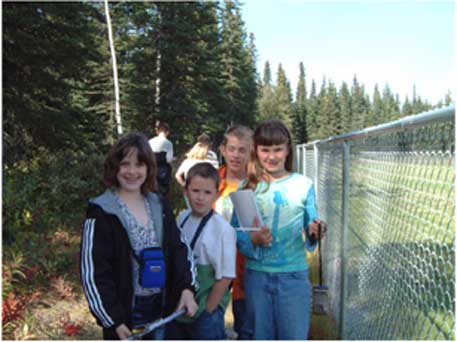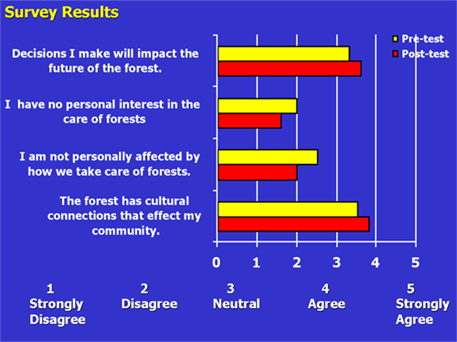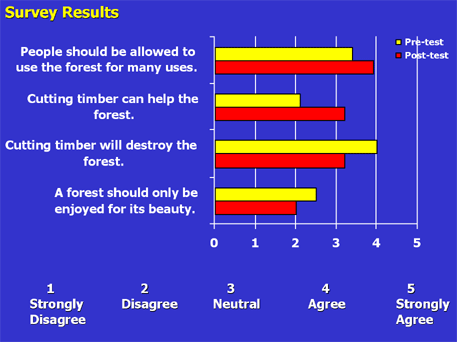August 2005 // Volume 43 // Number 4 // Ideas at Work // 4IAW3
What Is Forestry: A Multi-State, Web-Based Forestry Education Program
Abstract
The What Is Forestry: Connecting Communities
project promotes forestry education and connects students to a greater appreciation
of local and national forests and their cultural connections with communities.
Through integrating activities including science, photography, arts, music,
math, and Internet computer technology, students were challenged to observe
and explain the forests in which they live and communicate this understanding
to students in a sister school in another state. The analysis of the pre-
and post-evaluations indicated that there were significant changes in student
opinions about forestry.
Introduction
What Is Forestry: Connecting Communities, a Web-based <http://www.uaf.edu/coop-ext/forestry/wif/> forestry education program, was developed through the combined efforts of the Cooperative Extension Services in Alaska and Kentucky and was funded by a grant for the University of Alaska.
This year-long forestry education program was designed for primary level (4th and 5th grades) and its mains goal were:
-
To promote education and connect people to a greater appreciation of forests and their cultural connections with communities and
-
To create a program that is fun, exciting, and challenging
Emphasis was put on building student interest and involvement in forestry through multiple means of educational experiences, including science, math, art, photography, poetry, music, and hands-on field activities. Through these activities, students were challenged to build a better understanding and appreciation of community forestry resources. Success of the program was measured by the combination of pre- and post-program surveys as well as through the use of concept mapping.
The Program
Schools Involved in the Program
The initial offering of the program was conducted with three 4th grade classes at Kalifornski Beach Elementary School in Soldotna, Alaska, and with 5th grade classes at Issonville Elementary, Lakeside Elementary, and Sandy Hook Elementary schools in Elliott county in eastern Kentucky.
To assist both students and teachers with the sharing of their community-based forestry activities through the Web site <http://www.uaf.edu/coop-ext/forestry/wif/>, sister school classes were assigned between the Alaska and Kentucky schools. Through the Web site, students and teachers were able to interact, learn about forestry, and share digital images.
The Web Exchange
The design of the program involved not only students conducting the activities identified in the unit, but also an associated interchange of information through the WIF Web site with their sister school classroom. The teachers also had a Web page of their own with necessary teaching and support materials.
The WIF-CC program was developed around seven educational units. Each unit was designed as a learning cycle model and was aligned with core content and both Alaska and Kentucky educational standards. Each unit has a 5E learning cycle (engage, explore, explain, expand, evaluate), a culminating project, and an associated cultural activity.
Starting the Program--The Introductory Unit: What Is a Forest and Why Is Mine Different?
This introductory unit involved students measuring and observing their forests and then comparing their observations with forests in the partner state. In order to better understand and describe their local forest, students measured a forest inventory plot and collected information on tree species, age, height, and diameters. Additionally, each class was responsible for creating digital postcards for sharing on the WIF-CC Web site.
Students in both states were assigned to teams to capture images of select forestry topics, such as forest products, recreational activities, colors of the forest, jobs, water, road and access, and forest organisms.
Figure 1.
Digital Image Camera Team During Field
Trip from Kalifornski Beach Elementary School in Soldotna, Alaska

Results of the Program
Pre- and Post-Program In-Services
During August 2001, prior to the start of the school year, a pre-program in-service was conducted in order to introduce the participating teachers to the program and use of the web site. During April 2002, a post-program in-service was conducted with the participating teachers during which they listed the following achievements of the program.
- Greater understanding of their own community and state and the influence of forests
- Increased feeling of commonality between AK and KY as human beings
- Students' awareness of how important the forest is to our community
- Learning different vocations from the forest
- Cultivating relationships
- Realizing that forests impact them/us
- Learning that not all forests are like theirs
- Putting together geography with the people and forests
- Awareness of differences in tree species
- Use of the Web to search information
- Getting the experience of meeting teachers from Alaska and sharing information
- Connecting the science contents to the forestry unit
- Students broadening their knowledge base of forest even in their backyard
- Students becoming aware of the diverse uses of the forest
- Students finding many similarities between people from Alaska and Kentucky
- Students becoming aware that some of their relatives are famous
Culminating Activities
Each unit of study required students to do a culminating project. These projects could be done individually, as a group, or as a class and were intended to provide examples of application for the information provided in the unit. A listing of some of the culminating projects conducted include:
- Making a movie on the forest
- Making a PowerPoint presentation
- Presenting a play
- Giving a presentation during parents night at the school
- Writing articles for newspapers
- Creating posters
- Writing poems
- Creating Venn Diagrams
- Field trips conducted by each class to local forest areas
Evaluation for the Project
A What Is Forestry Baseline Survey was conducted both pre- and post- program for both teachers and students with the results shown in Table 1.
|
Please circle the response number that best reflects your agreement with the following statements:
|
AK and KY Students |
AK Students |
KY Students |
All Teachers
|
||||||||
1 Strongly Disagree |
2 Disagree |
3 Neutral |
4 Agree |
5 Strongly Agree |
||||||||
|
Pre-test |
Post-test |
Pre-test |
Post-test |
Pre-test |
Post-test |
Pre-test |
Post-test |
|||||
|
1. A forest should only be enjoyed for its beauty. |
2.5 |
2.0* |
2.7 |
2.4 |
2.4 |
2.0* |
2.3 |
1.8 |
||||
|
2. Cutting timber will destroy the forest. |
4.0 |
3.2* |
3.6 |
3.1 |
4.2 |
3.2* |
2.1 |
1.8 |
||||
|
3. Cutting timber can help the forest. |
2.1 |
3.2* |
2.7 |
3.3 |
1.9 |
3.2* |
3.6 |
4.2 |
||||
|
4. People should be allowed to use the forest for many uses. |
3.4 |
3.9* |
3.8 |
3.3 |
3.4 |
4.0* |
4.5 |
4.8 |
||||
|
5. The quality of my life is affected by forests. |
3.4 |
3.9* |
3.5 |
3.8 |
3.4 |
4.0* |
4.6 |
4.8 |
||||
|
6. Forest products are important in my daily life. |
4.0 |
4.3* |
4.2 |
4.2 |
4.0 |
4.3* |
4.8 |
4.6 |
||||
|
7. Decisions I make will impact the future of the forest. |
3.3 |
3.6* |
3.3 |
4.2* |
3.2 |
3.5* |
4.4 |
4.8 |
||||
|
8. I have no personal interest in the care of forests. |
2.0 |
1.6* |
1.8 |
1.7 |
2.0 |
1.6 |
1.9 |
1.2 |
||||
|
9. I am not personally affected by how we take care of forests. |
2.5 |
2.0* |
2.5 |
1.4* |
2.5 |
2.1* |
1.9 |
1.2 |
||||
|
10. The economic well-being of my local communities is related to forestlands. |
3.4 |
3.6 |
3.2 |
3.4 |
3.5 |
3.7 |
3.5 |
3.4 |
||||
|
11. The forest has cultural connections that affect my community. |
3.5 |
3.8* |
3.6 |
3.6 |
3.5 |
3.8* |
4.3 |
4.2 |
||||
|
12. Forestry is not something that has direct impact on my community. |
2.6 |
2.4 |
2.5 |
3.0 |
2.6 |
2.3* |
1.8 |
1.4 |
||||
|
13. Healthy forests make healthy communities. |
4.1 |
4.1 |
4.1 |
4.4* |
4.0 |
4.1 |
4.0 |
4.4 |
||||
|
14. My community and my forest are related. |
3.7 |
3.9 |
3.6 |
3.9 |
3.7 |
3.9 |
4.1 |
4.6 |
||||
|
How important would you say are the following purposes of managing or making decisions about a forest: |
||||||||||||
| 1 Very important |
2 Somewhat important |
3 Not at all important |
||||||||||
|
15. To provide money for forest land owners |
1.8 |
1.7 |
1.9 |
1.8 |
1.8 |
1.7 |
3.0 |
3.4 |
||||
|
16. To provide timber and other resources for use by this generation |
1.5 |
1.4 |
1.6 |
1.5 |
1.5 |
1.3 |
1.4 |
1.6 |
||||
|
17. To establish wildlife habitat |
1.2 |
1.2 |
1.3 |
1.2 |
1.2 |
1.7 |
1.1 |
1.0 |
||||
|
18. To maintain wildlife habitat |
1.3 |
1.2 |
1.5 |
1.3 |
1.2 |
1.2 |
1.0 |
1.0 |
||||
|
19. To maintain the quality of the forest for future generations |
1.5* |
1.2* |
1.5 |
1.3 |
1.4 |
1.3 |
1.0 |
1.0 |
||||
|
20. To provide a place for recreational activities |
1.8* |
1.5* |
1.6 |
1.7 |
1.8 |
1.5* |
1.0 |
1.0 |
||||
| *Significantly different at alpha=0.05. Wilcoxon Signed Ranks Test for Non-parametric data | ||||||||||||
Survey results show significant differences were found in perceptions of forest harvesting as a management method for forests, an increase in the tolerance for multiple uses of forests, an increase in personal connection to the care of forest, an increase in awareness of the quality of life and forest care, and an increase of the awareness of the cultural connections forests have to communities.
Figure 2.
Graphs of Results from the
Pre and Post What Is Forestry Survey

Figure 3.
Graphs of Results from the Pre- and
Post- What Is Forestry Survey

Figure 4.
Graphs of Results from the Pre- and
Post- What Is Forestry Survey

Concept Maps
In addition to the pre- and post- program baseline surveys, pre- and post-program concept maps were obtained. Concept maps are pictorial representations of concepts with lines used to represent the relationships between concepts (Lanzing, 2002). The concepts and lines are labeled on the concept map. Once completed, the concept map is a visual graphic that represents how a person thinks about a subject, topic, etc. Concept maps were drawn on the each of the three subjects, What Is Forestry or Forest, My Community, and The Importance of the Forest to My Community at the beginning of the 2002 school year and in February of 2003 school year to assess how much was learned. Points for each concept map were added together. The total number of points each student was earned was based on the following scoring method.
1pt. Number of relevant concepts
1pt. Number of times
words linked concepts together
1pt. Number of times branching occurred.
3pts. Number of crosslinks
between concepts
1pt. Number of examples of concepts.
Significant differences were found in students' concept of the forest showing an increase in concepts, examples, and how concepts were linked together (Table 2 and Figure 5).
|
Concept Map |
All Students AK & KY |
AK Students |
KY Students |
|||
|
Pre-test |
Post-test |
Pre-test |
Post-test |
Pre-test |
Post-test |
|
|
What Is Forestry (Forest) |
10.4 |
16.5* |
7.0 |
12.2* |
44.0 |
56.3 |
|
My Community (KY only) |
11.5 |
23.8 |
11.5 |
23.8 |
||
|
The Importance of the Forest to My Community (KY only) |
6.5 |
18.9 |
6.5 |
18.9 |
||
| *Significantly different at alpha=0.05. Wilcoxon Signed Ranks Test for Non-parametric data. | ||||||
Figure 5.
Graphs of Concept Mapping
Results

Conclusions
The success of the What Is Forestry: Connecting Communities program was reflected in the diverse list of activities, culminating projects, student involvement, and hands-on learning. Students and teachers were surprised at how similar their interests and activities were in spite of great differences in the forests of the two states. More work is needed to further enhance the Web site, but it is believed that the What Is Forestry: Connecting Communities program has opened the door for further application of the program on a national level to assist students from different states to teach each other about their local forests.
Reference
Lanzing, J.W.A. (1996, August). Everything you always wanted to know about . . . Concept Mapping
